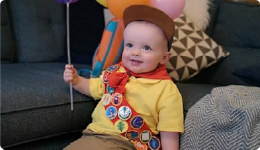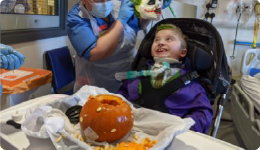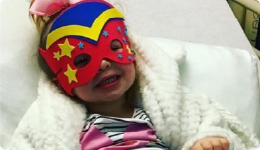Information about how and why autism affects our senses from Autism Understood.
Sensory Processing

- Being a Detective: Understanding Your Child’s Behaviour
- What is Sensory Processing?
- Our 8 Senses
- Strategies To Try
- Online Session
- Sensory Questionnaires and Strategies
- All About Me
- What Next?
- Other Sensory Resources
Everybody experiences the world around them in different ways. Sometimes how your brain understands information from your senses can make it difficult to join in with every day activities. This page contains resources to help you understand sensory processing and how you can support your child or young person. You can choose the resources that are right for you.
Being a Detective: Understanding Your Child’s Behaviour
 Children and young people may take part in activities differently for many reasons. It’s not always easy to understand why, especially if they find it hard to explain what they’re feeling.
Children and young people may take part in activities differently for many reasons. It’s not always easy to understand why, especially if they find it hard to explain what they’re feeling.
Sometimes, it can be because of how they process sensory information. But there can be other reasons too, such as:
- Trying to communicate something
- Feeling unwell
- Feeling overwhelmed or stressed.
To begin understanding what’s going on, try asking yourself these questions:
- What have you seen?
- Why is it a problem?
- Who is it a problem for?
- Why do you think your child is doing this? What’s your best guess?
- Based on what you know, what might be driving the behaviour?
Here is an example
- What have you seen? - My child often runs off when we go to the supermarket.
- Why is it a problem? - It’s unsafe. I worry they could get lost or hurt. It also makes everyday outings very stressful and difficult to manage.
- Who is it a problem for? - My child because they might be at risk, and for me as a parent because I’m constantly worried and have to stay on high alert.
- Why do you think your child is doing this? What's your best guess? Based on what you know, what might be driving the behaviour?
-
They might be overwhelmed by the noise of the supermarket
-
They might have seen something they like and want to run towards it.
-
They might not know what they are supposed to do in the shop.
-
They might be trying to tell me they don't want to be there as running away always means we leave the shop quicker.
-
They might like me running after them and think its a game.
-
In this example you can see that there are lots of reasons why the child might be running off in the supermarket. Using sensory strategies will only help if the child is finding the noise at the supermarket overwhelming. If you think one of the most likely reasons for the behaviour you are seeing could be sensory then try filling in the sensory questionnaire and use the sensory strategies.
We can only support children to participate once we understand what they are motivated by and what is meaningful to them. The way a person processes sensory information may or may not be the reason they have difficulty taking part. If we focus too quickly on using sensory strategies, we can miss other reasons they might be having difficulty taking part.
If you think the reason is due to sensory processing differences read on.
This page has tools to help you learn more and support your child. You can choose what works best for you:
- Watch the videos - Learn about sensory processing and how to help
- Read the video scripts - You can download and translate them
- Fill in the sensory questionnaires - These help you understand your child’s preferences
- Download booklets and guides - Find tips and ideas to try at home.
Sensory Videos and Scripts
What is Sensory Processing?
What is Sensory Processing? Video Script
Our 8 Senses
Strategies To Try
Strategies to Try Video Script
Online Sessions
We want to make sure that we are giving information in the way you learn best so that it makes sense and you can use it at home. We know there is a lot of information to take in.
Information Session
The aim of this session is to help you learn about what sensory processing is and how you can change the environment to support your child/young person.
This workshop is for parents/carers of children/young people who have sensory processing differences. The workshop is suitable for people with no previous knowledge of sensory processing. You will learn more about what sensory processing is, the eight different senses and changes you can make to the environment to support your child/young person. The information presented in the session is the same as the videos above.
This session is only available to families of children and young people who live in the NHS Greater Glasgow and Clyde area.
Before registering please answer the following questions:
- Do you live in the NHS Greater Glasgow and Clyde area?
- Are you a parent/carer of a child/young person with sensory processing differences?
- Have you checked you can access Microsoft Teams?
If you have answered 'yes' to all of these questions then you can register by clicking on the dates below.
If you answered 'no' to any of the questions you can watch the videos above. If you live in NHS Greater Glasgow and Clyde you can also phone the Occupational Therapy Advice Line if you have any questions.
'New' Peer Problem Solving Session
Would you like to explore how your child or young person’s sensory differences affect their everyday life? Every child/young person is unique - there’s no “one-size-fits-all” solution.
Join our online session to share experiences, problem-solve together, and get support from other parents, carers, and our occupational therapists.
This session gives you the chance to:
- Talk about how sensory differences impact your child/young person’s participation in the activities they want and need to do.
- Identify possible changes and strategies with guidance from occupational therapists and insights from other parents and carers.
Before you sign up:
- This is for parents and carers in the NHSGGC area ONLY.
- You need an understanding of sensory processing and the 8 sensory systems. Use our other resources on this page before you attend the session.
Sign up here: Online Peer Problem Solving Session:
Sensory Questionnaires and Strategies
Information on each sensory system is available in 3 different age ranges. Complete the questionnaire most appropriate for your child or young persons’ developmental level. For example, if your 6 year old has an intellectual disability and is functioning at age 2 years, the strategies in the 2-5 year old questionnaire will be more helpful.
Sense of Body Awareness / Proprioception

Sense of Body Awareness 2-5 Years
Sense of Body Awareness 5-12 Years
Sense of Body Awareness 12-18 Years
Sense of Hearing
Sense of how the body is feeling / Interoception
Sense of how the body is feeling 5-18 Years
Sense of Movement and Balance / Vestibular
Sense of Movement and Balance 2-5 Years
Sense of Movement and Balance 5-12 Years
Sense of Movement and Balance 12-18 Years
Sense of Smell and Taste
 Sense of Smell and Taste 2-5 Years
Sense of Smell and Taste 2-5 Years
Sense of Smell and Taste 5-12 Years
Sense of Smell and Taste 12-18 Years
Sense of Touch
Sense of Vision
All About Me
It can be helpful to share what you know about your child/young person's likes, dislikes and triggers with anyone they spend time with regularly. You can write an 'All About Me'. Having a quick reference will help others to reduce stressful experiences and support coping strategies.
Top Tips for 'All About Me'
- Keep it to one page
- Keep it somewhere accessible
- Share it with anyone who comes into contact with your child/young person
- Keep it updated
You can use our blank template or look at the extra guidance to see what to include.
What Next?
 Different strategies work for different people. It is important to work together with your child to try out different strategies. Please don’t expect big changes overnight. It can take several months for sensory strategies to be used effectively. Try to use the strategies you think work best for you and your child consistently for 3 months. If you still need help or advice after this time and you live in the Greater Glasgow and Clyde area you can contact the Occupational Therapy Advice Line.
Different strategies work for different people. It is important to work together with your child to try out different strategies. Please don’t expect big changes overnight. It can take several months for sensory strategies to be used effectively. Try to use the strategies you think work best for you and your child consistently for 3 months. If you still need help or advice after this time and you live in the Greater Glasgow and Clyde area you can contact the Occupational Therapy Advice Line.
Children's Occupational Therapy Advice Line
Specialist Children Services (SCS) Community Occupational Therapy Team have an advice line where parents/carers, education staff, social care staff, voluntary organisations or other health professionals can seek advice and support for children and young people who are having difficulty joining in with the activities that they need and want to do every day.
Areas that we can help with include:
- Self-care - dressing, eating, washing, going to the toilet.
- Work - participating in nursery and school activities.
- Play - Playing with toys, playing outside and joining in at clubs/sports.
If you live in Glasgow City, East Dunbartonshire, West Dunbartonshire or East Renfrewshire
Call 0141 531 6536 on
Tuesdays 1:30pm - 4:00pm
Fridays 9:30am - 12:00pm
or email ggc.scsoccupationaltherapy@ggc.scot.nhs.uk
If you live in Renfrewshire or Inverclyde
Call 0141 314 4624 on
Thursdays 9:30am - 12 noon
If you need the assistance of an interpreter to make a telephone call to an NHSGGC service please visit Interpreting Services for more information.
Other Sensory Resources
Falkirk Council Children with Disabilities Team have published 2 booklets that you can download which provide lots of useful information and ideas for supporting your child's sensory behaviours. Look for Making Sense of Sensory Behaviour and Making Sense of Your Sensory Behaviour.
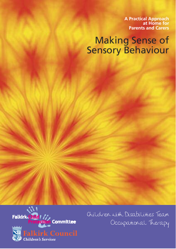
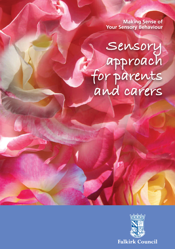
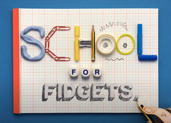 The School for Fidgets video from Gateshead Health NHS Foundation Trust uses the voices and illustrations of children and young people to share when and why they have to fidget or chew and how they feel if they can't do what they need to do.
The School for Fidgets video from Gateshead Health NHS Foundation Trust uses the voices and illustrations of children and young people to share when and why they have to fidget or chew and how they feel if they can't do what they need to do.
Our sensory system works throughout the day to keep our system balanced. We need different amounts of input to feel comfortable or ready to learn. We use our different sensory likes and dislikes to help keep our system balanced. This allows us to feel ‘just right’ for taking part in the activity we are doing. We call this sensory regulation. For example, some people find it easier to concentrate when the radio is on, others need silence. Adults have usually worked out what they need to feel 'just right'. They can find a way to do what they need to do to help them. Children and young people sometimes need adult support to work out what helps and to find the right activities or resources.
It can be helpful to pull together a collection of toys, activities and materials that your child/young person can use to keep their system balanced. Keeping these resources together means they are easy to find when they are needed. A sensory box/bag is a box or bag filled with things for your child/young person to explore. Sensory boxes/bags can be used in different ways for different purposes. If your child hates going to the shops but it is unavoidable then taking their sensory box could make it easier. Some public places have sensory bags you can borrow during your visit. Some children/young people like to play with the things in their box during the day just for fun.
Here are some top tips for making a sensory box/bag for your child/young person.
Sometimes people don't like the feel of a toothbrush or the taste of toothpaste. It takes time to get used the taste and feeling of toothpaste and toothbrushes. Take your time. Be consistent. Children under 7 years need help from an adult to help them brush their teeth.
Things to Try
- Try different toothbrushes until you find the one that suits your child/young person.
- A small headed toothbrush with a straight handle and medium bristles is ideal.
- Speak to your dental health care professional for advice if this doesn’t suit your child/young person.
- Try a battery operated toothbrush that has a slight vibration. They might like the feeling better. If they do, move onto an electric toothbrush with a small head.
- Try different brands of toothpaste, remember it needs to be 1450ppm (always check the label).
- Non foaming/SLS free toothpaste can be good for anyone who dislikes the foamy texture of standard toothpaste. Often this type of toothpaste is less minty.
- Unflavoured toothpaste can be helpful for people who dislikes strong flavours. It is often non-foaming.
- Speak to your dental healthcare professional for advice.
- Use a timer to make sure they brush for at least 2 minutes. Or why not try putting on their favourite song while they brush.
- If using a toothbrush and toothpaste is too much make sure you speak to their dental healthcare professional. They will be able to tell you what to try next.
- Get them to look in the mirror when they are brushing your teeth. Try a small mirror on a stand if they can’t see in the bathroom mirror.
Many people find the sensory experiences of going to the toilet challenging. We can change the environment to make going to the toilet easier. Understanding your child/young person's sensory preferences can help you work out what might be causing problems. You can complete the questionnaires on this page to help you work out their preferences. For more information look at:
- Sensory Needs and Toileting from ERIC.
The term smearing is used to describe people spreading poo on walls, furniture, themselves…anywhere apart from the toilet/potty or pants/nappy. Some children/young people who are learning to clean themselves after using the toilet might get poo on their hands. They might then wipe the poo off on the wall, their clothes or somewhere else. If this is the situation then look at the cleaning ourselves after using the toilet section. For more advice and support on managing smearing look at:
- Smearing from ERIC for more advice and support
- Smearing from The National Autistic Society
- Understanding why some children smear poo in Other Bowel Issues under Bowel Information in the Information Library from Bowel and Bladder UK
The onset of periods can be particularly challenging for some neurodivergent young people or others who have sensory processing differences. Periods involve a lot of new sensory experiences including:
- the feeling of blood leaking from the vagina
- the smell of the blood or the sanitary products (either when new or used)
- the look of blood in pants or on toilet paper
- the feeling of the sanitary towel or period pants
- the fear of touching the blood
- the feeling of stomach cramps, sore breasts or other hormone related body changes.
Your child/young person may not be able to identify what is making them feel uncomfortable or distressed so trial and error may be required to get to the bottom of it.
Things to try:
- Experiment with hygiene products: different brands of sanitary towels, menstrual cups, tampons and period pants, to find what is most comfortable and preferred. If appropriate for your child/young person, treat it as a science experiment or adventure where records are kept of what has been tried, what the outcome was (good things and bad things about each product) and what is next.
- Changing towels, tampons, or pants more frequently may help reduce the smell. A perfume or body spray that your child/young person likes may help cover smells. Many disposable sanitary products are perfumed. If this is an issue, then look for unscented products or reusable products.
- Using disposable gloves may reduce anxiety about touching blood – gloves that fit well are easier to use.
- Have wipes available – teach your child/young person not to flush wipes down the toilet, dispose of them in the bin.
- If your child/young person is afraid or anxious about blood, you may need to prepare them well in advance, using pictures such as those included in the resources below.
- If your child/young person is struggling with severe pain, heavy periods or mood swings, discuss with your GP what would be helpful to manage these symptoms.











